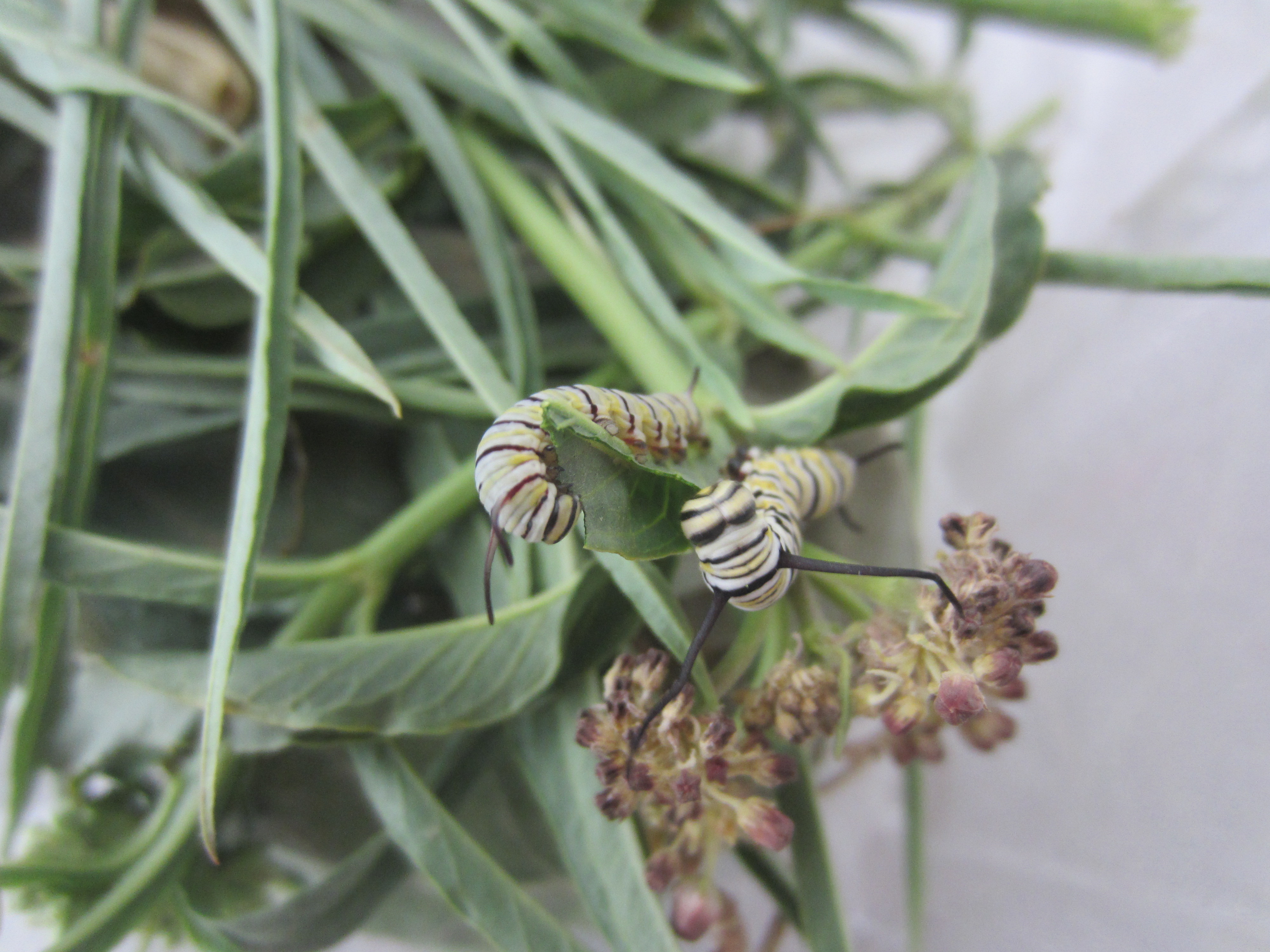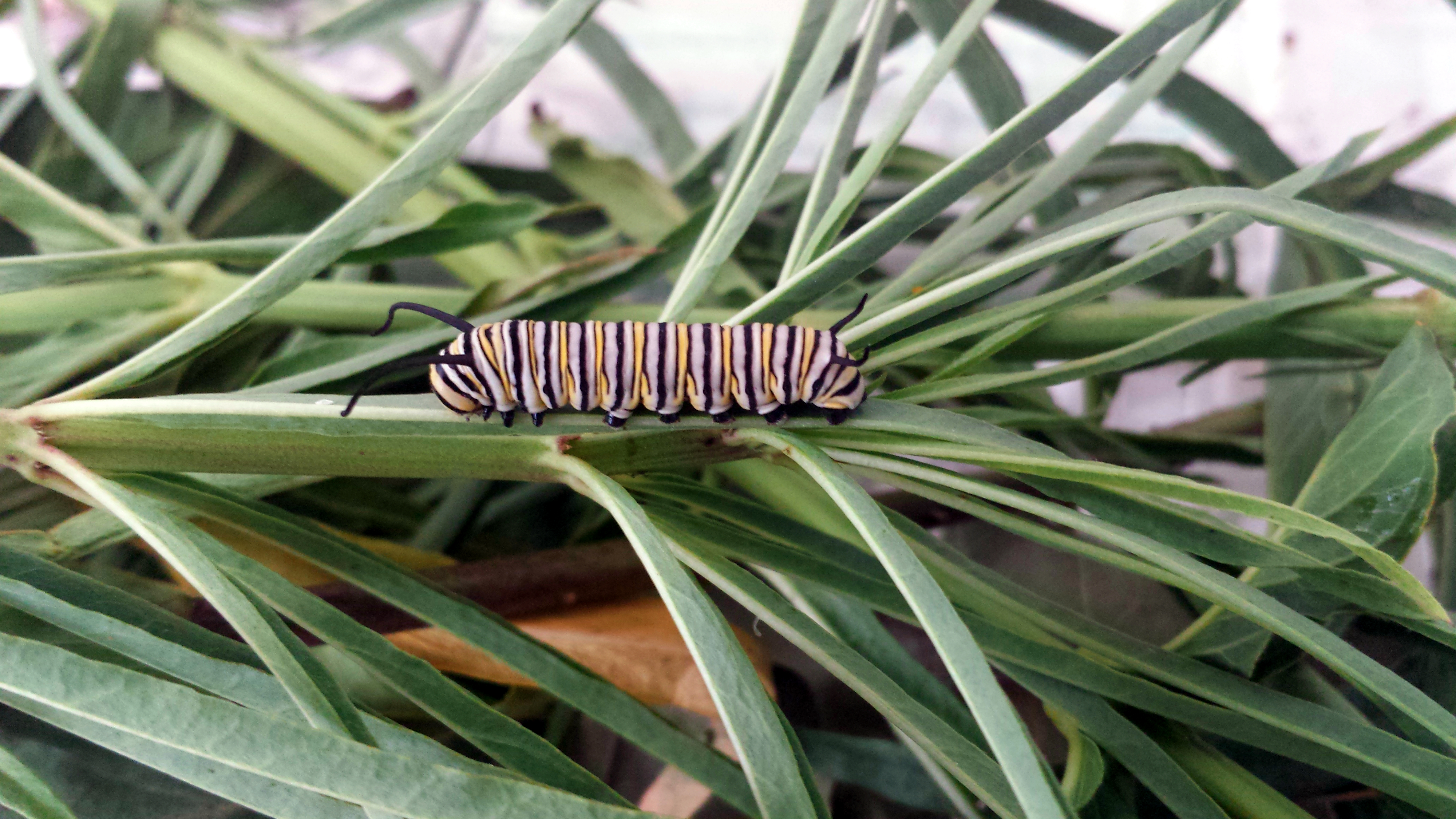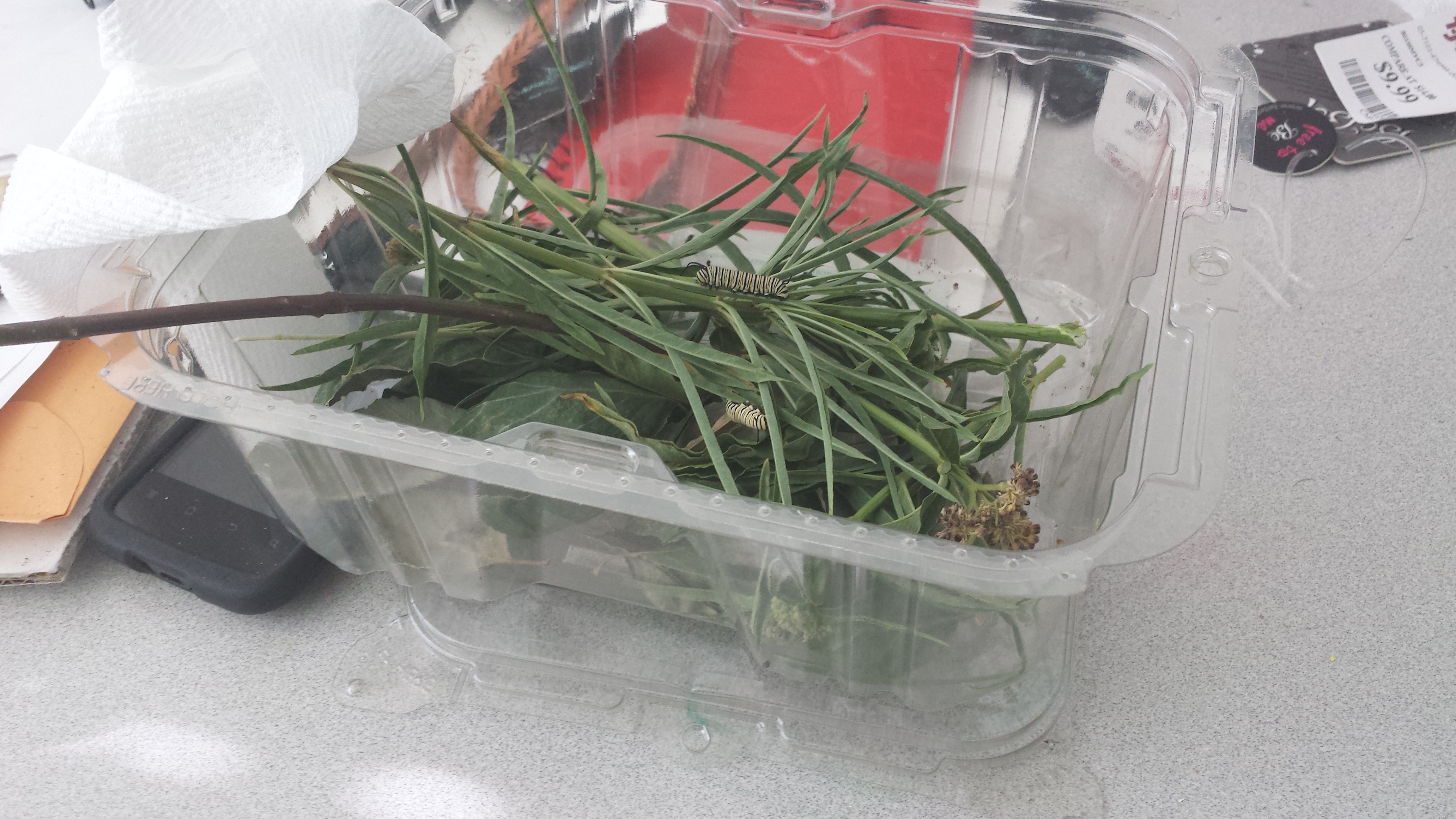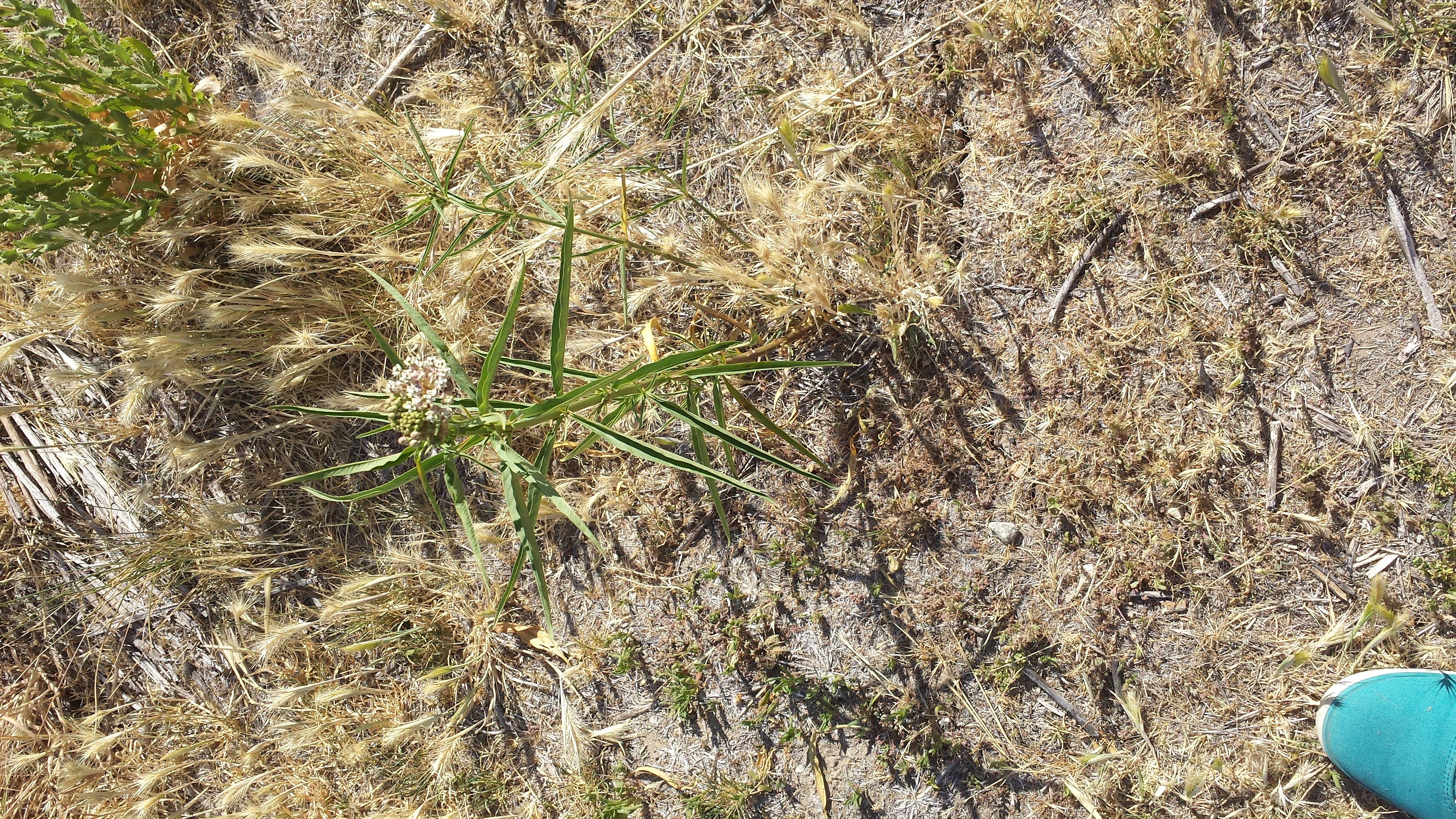Update: Caterpillar Craze
My collaboration with caterpillars officially began today. I came home on a hot day and texted my friend and neighbor Louie (a wildlife and ecology major) about going to look for caterpillars. Louie is very good at finding many kinds of local animals. In fact, he has found caterpillars and other animals for some of his other friends, too. He responded immediately and it turns out I caught him at just the right time. We headed over to the habitat restoration site across the street from my apartment, where Louie had seen patches of milkweed. It didn't take long for us to find the first one in the first patch we came across. I learned how to identify milkweed so that I could restock when needed. The first caterpillar and its plant went into my habitat container, an emptied plastic salad box. I spotted the second caterpillar in the next patch, and Louie found a third in another patch. Just like he said, there is usually one caterpillar per patch of milkweed. I really lucked out with the time of year. Monarch caterpillars are rarely found between July and January.
Another interesting side observation: Small red beetles were mating on milkweed. Apparently itís the only plant they reproduce on. Milkweed is a toxic plant to ingest and it is probably a safe for several species to live on since herbivores probably avoid milkweed (my hypothesis). Monarch caterpillars are able to eat milkweed and therefore make themselves poisonous to predators. They are also poisonous as butterflies. Their bold stripes as caterpillars and their bright colors as adults warns predators of their toxicity (no source, just knowledge I previously acquired).
At first the caterpillars did not move in their new home. I wondered how lively they would be. My friend told me they are voracious eaters, and so I had a feeling their shyness was only temporary. Back at home, I checked in on them after a few minutes and they were already munching away! I observed them for quite some time.
There was one point during my observation when two of the caterpillars seemed to have a quarrel. When one touched the other while eating, the other twitched its head one way and the other, as if it was upset that there was another caterpillar around. Perhaps it was just getting in its way of eating. As I learned from my friend, one monarch caterpillar is usually found per milkweed patch. I read online (http://www.wikihow.com/Catch-and-Raise-Monarch-Caterpillars) that monarchs only lay one egg per plant. This could be to avoid competition and ensure that each individual has enough to eat. As far as I know, they do not fight with one another. The three of them are civil so far.
Iím quite fascinated by the bugs. I canít seem to stop watching themÖand especially photographing them. They have such beautiful striped markings and such adorable long antennae. Theyíre also mildly humorous to watch as they chow down on the leaves. There seems to be time intervals in which they eat and stay perfectly still. Iíll have to watch them and see if they all eat at the same times.
Based off of a Youtube video (https://www.youtube.com/watch?v=_li2EEX1Rk8) these caterpillars are approximately 5 or 6 days old. If thatís the case, then they will probably be looking for a place to start their cocoon soon! In the video, the caterpillar began on day 15. By day 25, the caterpillar had turned into a butterfly (10 day metamorphosis).
Unfortunately for me, the only leaves monarch caterpillars eat are milkweed leaves. These are long and skinny, and donít give me much to work with as far as pattern formation. Also, they seem to start at the end of a leaf and eat until they reach the base. I need to think of some other way to utilize their appetite for art. Now I need to think of what I can do to create art with my new friends.
Apparently there are several kind of milkweed, and some with much larger leaves. Common milkweed supposedly has huge leaves (https://www.youtube.com/watch?v=4MImjk8_whE). The milkweed leaves from outside are much too skinny for my idea, however, Iím hesitant to buy other kinds since Iím limited on time based on the life cycle stage of my caterpillars AND I read that the caterpillars are very susceptible to disease. I donít want to introduce strange microbes by adding leaves not native to the area I found the caterpillars in.
My options right now are to contact local garden store to see if they sell common milkweed or to think of something else to do. I contacted La Sumida today. I hope Iíll be able to think of something over the next few days!
[Write Comment]
Another interesting side observation: Small red beetles were mating on milkweed. Apparently itís the only plant they reproduce on. Milkweed is a toxic plant to ingest and it is probably a safe for several species to live on since herbivores probably avoid milkweed (my hypothesis). Monarch caterpillars are able to eat milkweed and therefore make themselves poisonous to predators. They are also poisonous as butterflies. Their bold stripes as caterpillars and their bright colors as adults warns predators of their toxicity (no source, just knowledge I previously acquired).
At first the caterpillars did not move in their new home. I wondered how lively they would be. My friend told me they are voracious eaters, and so I had a feeling their shyness was only temporary. Back at home, I checked in on them after a few minutes and they were already munching away! I observed them for quite some time.
There was one point during my observation when two of the caterpillars seemed to have a quarrel. When one touched the other while eating, the other twitched its head one way and the other, as if it was upset that there was another caterpillar around. Perhaps it was just getting in its way of eating. As I learned from my friend, one monarch caterpillar is usually found per milkweed patch. I read online (http://www.wikihow.com/Catch-and-Raise-Monarch-Caterpillars) that monarchs only lay one egg per plant. This could be to avoid competition and ensure that each individual has enough to eat. As far as I know, they do not fight with one another. The three of them are civil so far.
Iím quite fascinated by the bugs. I canít seem to stop watching themÖand especially photographing them. They have such beautiful striped markings and such adorable long antennae. Theyíre also mildly humorous to watch as they chow down on the leaves. There seems to be time intervals in which they eat and stay perfectly still. Iíll have to watch them and see if they all eat at the same times.
Based off of a Youtube video (https://www.youtube.com/watch?v=_li2EEX1Rk8) these caterpillars are approximately 5 or 6 days old. If thatís the case, then they will probably be looking for a place to start their cocoon soon! In the video, the caterpillar began on day 15. By day 25, the caterpillar had turned into a butterfly (10 day metamorphosis).
Unfortunately for me, the only leaves monarch caterpillars eat are milkweed leaves. These are long and skinny, and donít give me much to work with as far as pattern formation. Also, they seem to start at the end of a leaf and eat until they reach the base. I need to think of some other way to utilize their appetite for art. Now I need to think of what I can do to create art with my new friends.
Apparently there are several kind of milkweed, and some with much larger leaves. Common milkweed supposedly has huge leaves (https://www.youtube.com/watch?v=4MImjk8_whE). The milkweed leaves from outside are much too skinny for my idea, however, Iím hesitant to buy other kinds since Iím limited on time based on the life cycle stage of my caterpillars AND I read that the caterpillars are very susceptible to disease. I donít want to introduce strange microbes by adding leaves not native to the area I found the caterpillars in.
My options right now are to contact local garden store to see if they sell common milkweed or to think of something else to do. I contacted La Sumida today. I hope Iíll be able to think of something over the next few days!

|

|

The caterpillar residence |

Wild milkweed near San Clemente Housing |
[Write Comment]
Project Updates
05/18/14 12:53:57 - Last entry was from 5/15
Just a note: my last entry was written on Thursday, 5/15.
[Write Comment]
Just a note: my last entry was written on Thursday, 5/15.
[Write Comment]
05/18/14 13:32:04 - Lost Collaborators
A few days ago I gathered three collaborators for my project. I kept them in an open plastic salad box so that they could get a decent flow of fresh air. I know now that I definitely should have poked holes in the lid and kept it on the box though, since I have lost two caterpillars. I have no idea where they went! My room is clean and there isn't much in there. The caterpillars were of decent size and I don't suspect they went far. Plus, they have only a limited range...they can't climb walls very well as far as I know, and they aren't very fast. I'm so surprised that they left the box. Every time I had observed them getting close to the edge, they would run out of milkweed stem or leaf and turn back around. I'm shocked they left their only food source, and now I'm a bit creeped out about finding them in random places when I least expect it. I hope I'm able to find them alive and bring them back to the enclosure. Otherwise, I'll either be finding a couple butterflies or a couple corpses :(
Well, this dumb move left me with only one collaborator. I'll have to make the most of our time together, or quickly come up with more caterpillars of perhaps another species.
[Write Comment]
A few days ago I gathered three collaborators for my project. I kept them in an open plastic salad box so that they could get a decent flow of fresh air. I know now that I definitely should have poked holes in the lid and kept it on the box though, since I have lost two caterpillars. I have no idea where they went! My room is clean and there isn't much in there. The caterpillars were of decent size and I don't suspect they went far. Plus, they have only a limited range...they can't climb walls very well as far as I know, and they aren't very fast. I'm so surprised that they left the box. Every time I had observed them getting close to the edge, they would run out of milkweed stem or leaf and turn back around. I'm shocked they left their only food source, and now I'm a bit creeped out about finding them in random places when I least expect it. I hope I'm able to find them alive and bring them back to the enclosure. Otherwise, I'll either be finding a couple butterflies or a couple corpses :(
Well, this dumb move left me with only one collaborator. I'll have to make the most of our time together, or quickly come up with more caterpillars of perhaps another species.
[Write Comment]